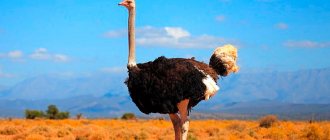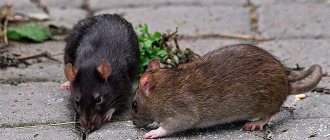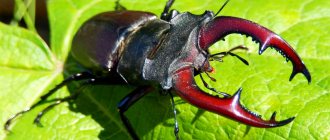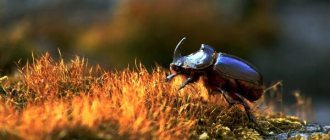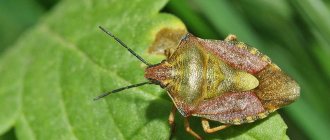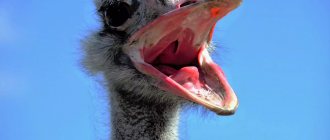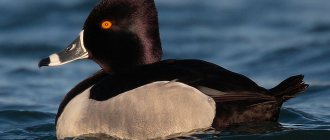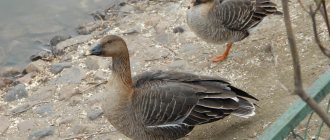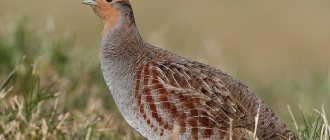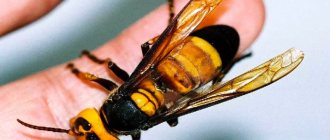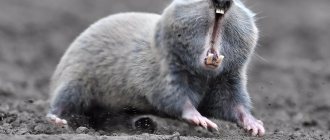Description of the African ostrich
The African ostrich is an unusually large bird that cannot fly and has no keel. The only species of ostrich that has survived to this day.
Origin
Scientists have found that the most ancient ancestor of these birds lived in South Africa about 23 million years ago. It was medium in size (smaller than now) and primitive. About 15 million years ago, some of the ostriches entered Turkey, and from there they spread throughout inner Asia.
Further evolution of these birds took place in Eurasia during the late Miocene. The climatic conditions were as follows: cooling, drying out of the territory. But savannas spread over the spacious fields, where these ostriches lived in a rather underdeveloped and primitive form for a long time.
Appearance
The African ostrich is the largest of all bird species currently known to scientists. Let's take a closer look at every detail of his appearance:
- Head. Quite small, flattened. The eyes are large, bright, usually with long thick eyelashes located on the upper eyelid, but none on the lower eyelid. Vision is very good. The hearing aid is clearly visible due to the weak feathering in the head area; the auricles resemble small human ears.
- Wings. Underdeveloped, they have fingers with claws. The plumage is evenly distributed throughout the body and is dense on the wings. Typically, males have black plumage, and females, which are noticeably smaller, are not so brightly colored - gray, off-white.
- Limbs. The feet of the African ostrich are completely without feathers, as is the chest. Strong, long limbs have 2 fingers, one of which has a kind of hoof. Their legs are so powerful that with one blow an ostrich can cause serious damage and even kill any large predator.
- Height and weight. These are the largest and heaviest birds in the world. Their height reaches 2.5 meters, and their weight is approximately 120 kg for the female and 150 kg for the male.
The ostrich has an incredibly long neck that stretches well, allowing it to swallow large prey whole.
Lifestyle and behavior
Ostriches can behave aggressively towards humans if they attack their territory. These cases are a rare occurrence, but nevertheless, this characterizes them as freedom-loving and wayward birds.
They prefer to lead a herd lifestyle. They can live in family groups, which consist of a male, several females and their offspring. The flock numbers up to 30 individuals, and young ostriches in the south live in a group of hundreds of birds.
African ostriches can often be around other herbivores, live together and be very friendly. Due to their tall stature and excellent vision, they can report danger to all animals nearby.
Hibernation
African ostriches are able to withstand winter well in the central zone of the CIS countries, which is due to their very lush plumage and genetically excellent health.
When kept in captivity, specially adapted warm poultry houses are built for such birds. Individuals born in winter are much stronger and more resilient in health than birds born and raised in summer.
Trumpeter Swan
- Weight: up to 17.2 kg
The trumpeter swan (Cygnus buccinator) is one of the heaviest flying birds on the planet. She lives in North America. The wingspan of these birds of this species can exceed 3 meters. The largest known trumpeter reached a length of 183 cm and weighed 17.2 kg.
At some point in history, trumpeter swans were almost destroyed: in the 19th and early 20th centuries they were actively hunted. By 1933, fewer than 70 wild whelks were known to exist in remote hot springs in or near Yellowstone National Park, and extinction seemed inevitable. But during an aerial survey of Alaska's Copper River in the 1950s, several thousand whelks were discovered. This population breathed new life into the species, and gradually the number of trumpeters increased to more than 46,000 birds by 2010.
Subspecies
To date, only 4 subspecies have survived that live in Africa. There used to be more of them, but due to the extermination of birds, their population has greatly decreased. Let's consider each subspecies separately:
- Common ostrich. The largest species. It has a bald spot on its head, and its paws and neck are colored pinkish-red. The female has whitish-pink skin instead of red. The egg of the common ostrich has star-shaped pores.
- Masai ostrich. Lives in East Africa. During the breeding season, its skin becomes bright red, the rest of the time it has a pinkish tint. Females have brownish-gray plumage and whitish limbs.
- Somali ostrich. Some scientists and researchers classify it as a separate species due to reproductive isolation revealed by DNA analysis. Female Somali ostriches are always larger than males. Their weight reaches 150 kg and their height is about 2.5 meters. The skin color of males is bluish-gray, while females have bright brown feathers.
- Southern ostrich. They are dirty gray and light black in color. The habitat is extensive: Namibia, Zambia, Angola.
Andean condor
- Weight: up to 15 kg
The weight of the Andean condor (Vultur gryphus) ranges from 11 to 15 kg for males and from 8 to 11 kg for females. The total length varies from 100 to 130 cm. The bird also has a very large wingspan - up to 3.3 m. Only four sea and waterfowl birds (wandering albatross, royal albatross, pink pelican and Dalmatian pelican) have a larger wingspan.
The Andean condor plays an important role in the folklore and mythology of the South American Andean regions. It is the national symbol of Argentina, Bolivia, Chile, Colombia, Ecuador, Peru and the peoples living at the foot of the Andes.
Natural habitats
Depending on the subspecies, the place of residence of the African ostrich varies. Most often, birds try to find the following natural conditions for life:
- Savannah. Ostriches, due to their natural characteristics and the need to quickly move, prefer grassy savannas and places with few trees. The plain is an excellent place for procreation and nutrition. On flat lands, you can clearly see all the animals nearby, including predators. Therefore, in case of danger, ostriches can flee in advance.
- Semi-desert. Groups of African ostriches can be found there while hatching eggs. However, they do not live in the Sahara Desert. Because it is difficult for birds to run on this kind of sand, which is necessary for them. The best option for life would be a semi-desert with hard soil and small bushes.
There are areas that ostriches try to avoid - these are mainly swampy areas, high impenetrable thickets of grass and trees, deserts with shifting sands.
Cassowary-muruk
- Weight: up to 26 kg
The muruk cassowary (Casuarius bennetti) ranges from 99 to 150 cm in length and weighs from 17.6 to 26 kg. It lives in the mountain forests of New Guinea, New Britain and Yapen Island (New Guinea) at altitudes up to 3300 m. In addition, cassowaries are the most dangerous birds on the planet. With their long sharp claws they are capable of killing a person with one blow.
Natural enemies
Ostriches have many different enemies in nature. Let's take a closer look at how serious and frequent the danger they pose:
- Predators. These are hyenas, jackals and birds that attack and destroy their nests with defenseless chicks. That is why during the period of incubation and growth of chicks, the population of African ostriches suffers enormous damage. But the offspring can run away from danger as early as 30 days after birth. Adults are attacked only by large predators: lions, tigers, leopards, cheetahs. But ostriches have effective methods of defense, so predatory animals attack with caution.
- Poachers. They are the ones who bear the most irreparable damage to the population. Hunters kill entire herds, about 30-80 individuals. They illegally sell skin, feathers, meat, and eggs of ostriches. There is currently only one method of combating poachers - breeding individuals on a farm in order to receive all the benefits from specially raised livestock, and not from killing all the birds.
- Tourists. For them it is just entertainment, so they enjoy hunting birds from helicopters. It is difficult to fight them and the authorities have banned the export of any type of ostrich products from the country.
Humans pose the greatest threat to African ostriches. Despite the camouflage, high speed, strong limbs and density of eggs, people have found a way to exterminate individuals for their own benefit.
Turkey
- Weight: up to 39 kg
The turkey (Meleagris gallopavo) was probably domesticated in central Mesoamerica at least 2,000 years ago. The English name "turkey" (another translation from the English word "turkey" - Turkey) is the result of an early erroneous identification of the bird with an unrelated species that was introduced into Europe through Turkey.
Birds can grow up to 39 kg.
African ostrich nutrition
Ostriches have a varied diet. They can eat grass, branches, roots, plants and flowers. But they will not refuse small rodents, leftover food from predators, and insects.
Since birds do not have teeth, they swallow small stones so that the food is better crushed in the stomach.
These birds can remain without water for a long time, and they obtain moisture from plants. However, when they find a body of water, they use its capabilities and not only drink, but also swim.
What do they eat?
The basis of the ostrich's diet is food of both plant and animal origin. As plant food, ostriches feed on various shoots, inflorescences, seeds and fruits of plants. The bird feeds on various insects, locusts, reptiles and rodents as animal food. Remains of food from various predators are often found. Younger individuals feed mainly on animal food.
To keep ostriches in captivity, it is necessary to take into account that an adult ostrich needs up to 3.5 kilograms of food per day, or even more. For food to be completely digested, the bird must swallow small stones or other hard non-food objects. This is due to the fact that the ostrich has no teeth and has nothing with which to grind food before swallowing.
It is believed that ostriches are quite hardy and can go without water for a long time, being content with the amount of moisture entering their body with food. Despite this, ostriches love to swim.
Ostriches. Life on the run.
Reproduction and lifespan
Before laying eggs, the male digs a hole himself. The main female of the flock incubates all the eggs for about 40 days. She does this all day long, leaving only to eat and chase small rodents. At night the male sits on the eggs.
One female can lay up to 10 eggs. The ostrich egg is the largest in the world. Its weight is 1.5-2 kg, and it is about 15 cm in length.
After 40 days, the chick hatches. This process takes about an hour. It breaks the shell with its beak and head. If some of the chicks from the offspring fail to emerge, the female herself pecks at the egg. Ostrich chicks weigh 1 kg, immediately begin to see, and have fluff. By day 30 they can already run quite fast.
The weight of ostriches becomes about 25 kg within six months after birth. After 2 years, males are covered with black feathers, before that they all look like females. Their development as a whole is characterized by a gradual and slow process. It takes a particularly long time for them to develop their plumage.
The maximum lifespan of an ostrich is about 80 years, but most of them live 35-40.
Australian emus
The height of the Australian flightless bird is 1 meter 50 centimeters, and the weight of the ostrich reaches 55 kg. Males have greater mass than females and can reach 100 kg. During egg laying, the male loses a third of his weight, because he is the one who incubates the chicks. The mother is getting food at this time.
Emus live in grassy and bushy areas and feed on pasture and insects. They enjoy eating cereal plants, so Australian authorities have decided to partially shoot ostriches if they cause harm to agriculture.
You can recognize an emu by its plumage, which contains all shades of brown. The head and neck have deeper dark colors, gradually becoming lighter at the bottom of the body. Emu has three toes on its feet, which are used for protection. The male and female look the same. You can distinguish them by raising the tail and pressing the cloaca. If the genital organ appears, it means there is a “boy” in front of you. Otherwise, you've looked under the lady's tail. However, not everyone will dare to take such peeks - an ostrich can easily kill a person with one kick. Thanks to their strong lower limbs, emus run at speeds of up to 51 km/h and are excellent swimmers.
Newborn chicks of the Australian flightless bird are very tiny - up to 400 g. The clutch includes up to 25 eggs, which means more than two dozen babies hatch at a time. The weight of one egg is 700 - 900 g, which corresponds to 10 - 12 chicken eggs in weight and volume.
The ostrich is an ancient animal. However, at some stage his mental development stalled. The tiny head contains an equally tiny brain. Ostriches are very shy and are afraid even of their own shadow, and as food they can easily feast on bottle caps or anything that fits in their beak.
Emu birds, weighing 160 kg
Domestication of the African ostrich
It is reliably known that attempts to domesticate the African ostrich occurred in the distant past in Ancient Egypt. However, only in the 19th century the first farm opened, which was located in America. After this, there were a lot of ostrich farms almost all over the world. Now they are bred in more than 50 countries around the world.
Birds are able to quickly adapt to harsh weather conditions, despite their African origin. It is not difficult for them to endure 30 degree frost, but sudden changes in temperature, drafts and wet snow have a particularly bad effect on birds, because of this they can get sick and even die.
Extinct ancestors
Dromornis stirtoni is one of the largest birds, whose thunderous steps shook the soil. The growth of Dromornis reached 3 meters. Weight – 0.5 tons. Dromornis was heavier than the extinct giant moa from New Zealand and taller than the also extinct elephant bird from Madagascar.
View this post on Instagram
A post shared by Victor Ray (@v1cr4v)
Dromornis stirtoni
The diet of Dromornis stirtoni is a subject of intense debate. Some scientists claim that the bird ate fruits and seeds. Others believe that it was omnivorous. Eggshell analysis supports plant-based diet advocates. As for relatives, it was first believed that Dromornis were related to ostriches and emus. But new research shows that the giant shares a common ancestor with geese and ducks.
View this post on Instagram
A post shared by Victor Ray (@v1cr4v)
Giant Moa
The giant moa is a skyscraper among birds. Height – 3.6 m. Weight – 250 kg. Distribution area: New Zealand. Diet – plant based. Moa is the tallest extinct bird.
Is it possible to breed it?
The ostrich is a large and exotic bird, but hardy and omnivorous. In order for a bird to live comfortably on a farm, the following conditions must be met:
- there should be a spacious grassy area nearby on which various plants will grow;
- the presence of an insulated poultry house, since ostriches love warm climatic conditions, even despite their endurance;
- For one male you need to keep 3-4 females, this ensures their proper reproduction.
It is important to handle birds carefully and carefully, because they can behave very aggressively during mating periods, protecting their chicks and eggs.
You can learn about breeding African ostriches in the video:
King Penguin
- Weight: up to 18 kg
The average weight of the king penguin (Aptenodytes patagonicus) is similar to or slightly higher than that of the largest living flying birds, the bustard and great bustard. It can reach 18 kg. The height of the birds ranges from 70 to 100 cm. Males are slightly larger than females. They are the second largest species of penguin (the largest is the emperor penguin, which you will read about on the next page).
Species protection
The ostrich needed radical and serious security measures. An organization that protects the Sahara decided to call on people to help save the population and return the ostrich to the wild. Today, the Sahara Fund has already achieved considerable success in protecting the African ostrich.
The company assisted in taking some important measures in the construction of nurseries and consulted with experts on the topic of poultry breeding in captivity. Great assistance was provided to one of the zoos in breeding ostriches.
A nursery has been created in an African village with all the necessary conditions for ostriches in the east. The support of the authorities helped bring a flock of birds to protected areas and release them into nature reserves to continue living in their natural habitat, in freedom.
Thanks to the measures taken to protect the bird, it is possible to avoid the rapid development of poaching and preserve the population.
The ostrich is a unique bird of its kind. It has a long history, is well suited for farming and does not require special living conditions. Many farmers are happy with the decision to start breeding ostriches, as they receive quite a lot of benefits from them.
0
0
Copy link
Common rhea
- Weight: up to 40 kg
Weighing 20-40 kilograms, rheas (Rhea americana) are the largest birds on the American continent. Strong powerful legs allow them to reach speeds of up to 56 km/h.
This species lives in Argentina, Bolivia, Brazil, Paraguay and Uruguay.
Tell your amazing story
GET 500 rubles
No. 12 Bustard
Weight: up to 18 kg.
This representative of the bird world can weigh up to 18 kilograms and is widespread throughout Asia and Europe, although the majority of the population is still found in Spain and Portugal. Probably, birds of this type are considered the heaviest. The height of males is up to 105 cm, although the minimum mark starts from 90 cm. As for the length, this figure is 115 mm, and the wingspan can reach 2.1-2.7 m. An adult male can have a body weight of up to 18 kilograms , while females can weigh half as much. There is another representative of this species, the African bustard. Judging by the name, it is easy to guess that it comes from Africa. The male has a length of 120-150 cm, and his height is up to 120 cm. As for the wingspan, it can be 2.75 m. As is the case with the common bustard, the masses of females and males vary almost twice.
